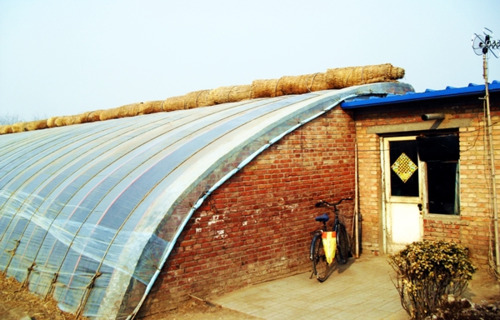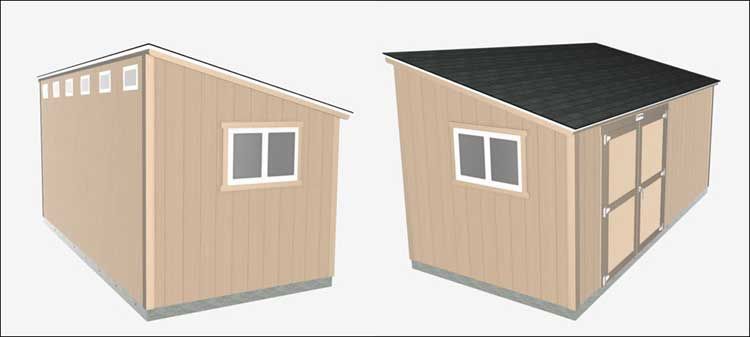Greenhouses

Having built and used a hoophouse (Sunmaster greenhouse film over 16' PVC pipe -12' wide x 6' tall x 30' long) from 2008 until quite recently (gave it to some young farmers for taking it down for me), I have lately been debating the merits of building a 'real' greenhouse. The hoophouse didn't work worth a damn as a place to grow vegetables. In the spring and summer it was too hot during the day for decent pollinization (tomatoes & peppers) and in early spring it was too cold at night to start seedlings without a heat mat. One really cloudy, cool summer it did an okay job at the tomatoes and a big crop of basil but other than that year, it was mostly just dry, covered space. Which is useful around here. But as a greenhouse it was a failure. Which led me to thinking about what really needs to happen in a greenhouse at this latitude (48 north) and in this climate (maritime Pacific northwest).
Clearly it needs to be able to maintain an air temperature below 85F and above 32F at all times that plants are growing within it. But how to do that? Then I found what has become one of my favorite websites:
https://www.lowtechmagazine.com/2015/12/reinventing-the-greenhouse.html
The Chinese have already figured this out.
I'm thinking that lining the back wall with steel barrels full of water would give me a heat sink to help reduce overheating during the day and to bleed heat back into the air overnight AND provide warm water for irrigation. I've read studies on the hours and hours it takes for a plant to recover the lost heat from being irrigated with cold water; warm water makes plants happier. Based on the studies done in Canada with these type of greenhouses at 50 degrees north, I am going to need a heat source in the winter if I expect to do anything more than keep the kale and cabbages alive. A rocket mass heater seems ideal for the application but I have zero experience with them and I already have a barrel stove built, so that is probably going to be the first try at heating.
Thanks to another GW forum on laundry, I am thinking that an old Maytag wringer washer and a clothesline are also going to live in the greenhouse. I'd like to incorporate a new raccoon-proof (okay nothing is actually "raccoon-proof", but at least seriously raccoon-resistant) chicken house into the structure and try to use the chicken's body heat and CO2 to help the plants grow. Chickens don't do well with dampness so there really should be some way of controlling the airflow between the chickens and the greenhouse; they can't just be in a wire pen inside the greenhouse. Or maybe they can? Has anyone combined their greenhouse with their chicken coop?
I also don't have a good plan for a thermal 'blanket'...
This is a obviously a design in progress but I'm really missing decent eggs and I have the time and construction skills; I just need to decide on a design and do it. Any thoughts?

Kay Robison
Fri, 01/07/2022 - 17:01
Permalink
Mixed feelings...
I have very mixed feelings about greenhouses. To date, my experiences with plastic film over any structure has not been real good. In the spring without some kind of fan to push the air around, it would get to cold and freeze the seedlings. That happened twice and even after I added fans, there were still cold spots.
When my Dad was still alive, every house they had in Vegas had a green house with the hot tub in the middle. Heat wasn't usually needed, but cooling was, so there was always a swamp cooler attached to be maintained and run constantly in the summer. Where I live now, I would probably need both heat and cooling. Insect pests were a big problem because you couldn't count on natural predators.
For the most part, I think green houses take too much work to be worth what they return on a small scale, but that is just my laziness speaking. Those big, half buried Chinese ones could be great with the right crop grown inside. At this time I find I don't really need one and I start my plants indoors under lights and move them out to a sheltered front porch as soon as they are big enough and so far the problems with this system have not out weighed the benefits gained.
I am sure there is a happy medium in there somewhere and I hope you find it for your own benefit. I will put my energy elsewhere.
David Trammel
Fri, 01/07/2022 - 19:23
Permalink
Lean To Green House
I'm planning a small green house added to my garden shed for the back yard but primarily as a method to start seeds and extend my growing season. Once it gets really cold I'll move my plants indoors. I have a small room set up in the basement for the garden stuff that will have three grow lamps. The way the budget and time is though, it won't get built til 2023.
Here's a picture of the shed I'd making.

I was going to have it built but now with the experience I've had with metal frames, I will probably have the corner posts, floor and roof built by a contractor I know then make the walls, install windows and doors, and side it myself. The size will be about 8'x16" so I can have a significant green house there even if its not that deep.
The green house will go on the tall side, which is the South face and extend to just under the windows. I don't have the room to make it walk in, so it will probably be a lean to design that the front opens like doors. I plan on making the roof over hang by a foot on that side then install temperature controlled vents at the top of the green house under the eave.
I may decide to build that South facing wall with thick hollow concrete blocks, then fill it with sand for a thermal sink. Paint that side black and it should help some with cold temperatures.
ADDED: A sloped lean would also allow me to put insulation blankets on it, up under the eaves, much like the picture from the Chinese green houses. Dropped into place in the evening, and those could mitigate the middle of the night loss of heat too.
Ken
Fri, 01/07/2022 - 19:41
Permalink
Rain barrel
Is there room for a rain barrel inside your lean-to greenhouse? That might be a good way to add some thermal ballast with a garden hose instead of a wheelbarrow! And have warm water for irrigating seedlings. You'd have to keep the mosquitos out of it of course...
Ken
Fri, 01/07/2022 - 19:34
Permalink
The first question should always be, "Do I really need this?"
I agree that greenhouses have plenty of problems! And they are far from magic, despite Elliot Colman's books. If you can get by without one, definitely don't bother! That actually is a pretty good principle for most things, now that I think about it!
David Trammel
Fri, 01/07/2022 - 20:41
Permalink
I've considered water storage
That is one of the options I'm considering. As you said, it would be as good if not better as a thermal mass, provide warm water for the seedlings if I plumb it right (perhaps heated shelves with a solar powered recirculation system) and provide an emergency water reserve. I want to experiment with rain water capture on the shed roof, small scale, before I install anything on the house, so that could top off the tank for any water use I need.
I could also install it at a later date than in the initial construction unlike the concrete wall. That could help me push the shed build into Fall 2022 which would help. Basement storage is at a premium right now with the living space going in. Unfortunately I've had to rent a storage locker ($120 a month) short term. That's an expense that is coverable with the income my part time job is providing but not one I'm happy with. I'll have to see what kind of rectangular tanks I can get that are modular and affordable, since plastic drums waste space when put side by side.
The shed is going on top of a concrete pad, with a good work area around two sides (pad will be 12'x24') with the shed put at one corner, so I can beef up the foundation under that location to provide support if I need to.
I'll need to do more cost analysis to decide.
Teresa from Hershey
Sat, 01/08/2022 - 12:38
Permalink
Would a skylight work on the shed roof?
Would a small skylight work on the shed roof?
They come in sizes, they can be fixed but operable would give you more choices with venting.
Even a small skylight (I have four solar tubes in my house about 14 inches across) will *flood* a space with sunlight.
Ken
Sat, 01/08/2022 - 15:41
Permalink
Free lighting
I'm generally not a fan of holes in the roof; every penetration is a potential leak. Skylights also tend to leak heat in a big way. But that only applies to houses. A shed is another story altogether. There's never enough light in tool sheds and an operable skylight (not cheap to purchase new but maybe from salvage?) might be a really good idea.
Teresa - What do you think of the thermal qualities of solar tubes? Do you ever have condensation problems with them? I've only installed one in my whole carpentry career and other than practically blinding me when I stupidly looked up the HIGHLY reflective tube, it actually went together far easier than building a skylight well. The amount of light produced didn't seem like that much during the middle of the day (about like a 40 watt incandescent bulb) but it looked surprisingly bright at night from the moon! I'm curious about your solar tube experiences as I see natural lighting inside homes and workshops as essential to designing and building structures that will continue to be useful at descending levels of technology. Without electric lights imagine how useless those gargantuan, windowless big box stores will be for anything except storing potatoes in...
Teresa from Hershey
Sun, 01/09/2022 - 14:58
Permalink
I've got an entire post on Green Wizards on solar tubes
I've got an entire post on Green Wizards about our solar tube experience.
Here's the link: https://www.greenwizards.com/node/949
It's got pictures!
We've been very pleased. No leaks at all. I do get some condensation in the green bathroom solar tube but that might also be because it's in the most used bathroom space in the house AND it's ventilated. The other ventilated tube is in a rarely used bathroom. The kitchen tubes are tubes only.
I have not noticed heat loss or heat gain. The way to get around it would be (I THINK) to build a box of insulation foam and install it around the solar tube in the attic. Maybe. What that might do is trap the ambient temperature instead of bleeding it off into the attic and possibly cause more issues. I dunno.
I think most of your questions are answered in the linked post.
Would I do it again? You bet I would.
David Trammel
Sun, 01/09/2022 - 15:38
Permalink
Soda Bottle Lights
I've not considered a sky light due to the small size of the shed, but I have considered mounting a few of the water filled 2 liter solar lights. I'd be concerned about leaks though.
"Make a solar light for your tool shed using a soda bottle"